

Welcome to the Charles Rennie Mackintosh website. Gustav Klimt. Life and work[edit] Early life and education[edit] Gustav Klimt was born in Baumgarten, near Vienna in Austria-Hungary, the second of seven children—three boys and four girls. His mother, Anna Klimt (née Finster), had an unrealized ambition to be a musical performer. His father, Ernst Klimt the Elder, formerly from Bohemia, was a gold engraver. All three of their sons displayed artistic talent early on. Klimt lived in poverty while attending the Vienna School of Arts and Crafts (Kunstgewerbeschule), where he studied architectural painting until 1883. In 1888 Klimt received the Golden Order of Merit from Emperor Franz Josef I of Austria for his contributions to murals painted in the Burgtheater in Vienna. During this period Klimt fathered at least fourteen children.[5] Vienna secession years[edit]
Lloyd Wright. Frank Lloyd Wright, Jr. (March 30, 1890, Oak Park, Illinois – May 31, 1978, Santa Monica, California), commonly known as Lloyd Wright, was an American landscape architect and architect, active primarily in Los Angeles and Southern California. His name is frequently confused with that of his more famous father, Frank Lloyd Wright. Early years[edit] Lloyd Wright's mother was Frank Lloyd Wright's first wife, Catherine Lee "Kitty" Tobin. Le Corbusier. Charles-Édouard Jeanneret-Gris, better known as Le Corbusier (French: [lə kɔʁbyzje]; October 6, 1887 – August 27, 1965), was a Swiss-French architect, designer, painter, urban planner, writer, and one of the pioneers of what is now called modern architecture.
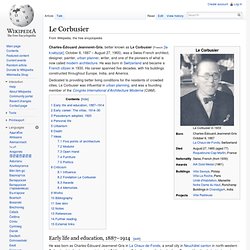
He was born in Switzerland and became a French citizen in 1930. His career spanned five decades, with his buildings constructed throughout Europe, India, and America. Dedicated to providing better living conditions for the residents of crowded cities, Le Corbusier was influential in urban planning, and was a founding member of the Congrès International d'Architecture Moderne (CIAM).
Early life and education, 1887–1914[edit] He was born as Charles-Édouard Jeanneret-Gris in La Chaux-de-Fonds, a small city in Neuchâtel canton in north-western Switzerland, in the Jura mountains, just 5 kilometres (3.1 mi) across the border from France. International style (architecture) - Wikipedia, the free encyclo. Cover of "The International Style" (1932) by Henry-Russell Hitchcock and Philip Johnson The International Style is the name of a major architectural style that is said to have emerged in the 1920s and 1930s, the formative decades of modern architecture, as first defined by Americans Henry-Russell Hitchcock and Philip Johnson in 1932, with an emphasis more on architectural style, form and aesthetics than the social aspects of the modern movement as emphasised in Europe.
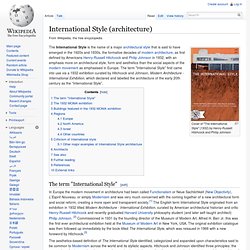
The term "International Style" first came into use via a 1932 exhibition curated by Hitchcock and Johnson, Modern Architecture - International Exhibition, which declared and labelled the architecture of the early 20th century as the “International Style”. The aesthetics-based definition of The International Style identified, categorized and expanded upon characteristics said to be common to Modernism across the world and its stylistic aspects. Bauhaus. The Bauhaus Dessau Typography by Herbert Bayer above the entrance to the workshop block of the Bauhaus, Dessau, 2005 Staatliches Bauhaus , commonly known simply as Bauhaus, was an art school in Germany that combined crafts and the fine arts, and was famous for the approach to design that it publicized and taught.
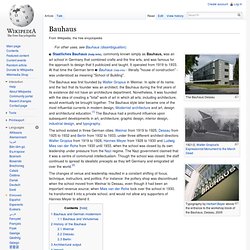
It operated from 1919 to 1933. At that time the German term Bauhaus - literally "house of construction" - was understood as meaning "School of Building". The Bauhaus was first founded by Walter Gropius in Weimar. The school existed in three German cities: Weimar from 1919 to 1925, Dessau from 1925 to 1932 and Berlin from 1932 to 1933, under three different architect-directors: Walter Gropius from 1919 to 1928, Hannes Meyer from 1928 to 1930 and Ludwig Mies van der Rohe from 1930 until 1933, when the school was closed by its own leadership under pressure from the Nazi regime. Antoni Gaudí. Antoni Gaudí i Cornet (Catalan pronunciation: [ənˈtɔni ɣəwˈði]; 25 June 1852 – 10 June 1926) was a Spanish Catalan architect from Reus, who was the figurehead of Catalan Modernism.
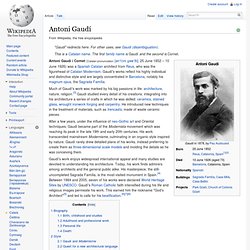
Wassily Kandinsky. Wassily Wassilyevich Kandinsky (/kænˈdɪnski/; Russian: Васи́лий Васи́льевич Канди́нский, Vasiliy Vasil’yevich Kandinskiy, pronounced [vaˈsʲilʲɪj kɐnˈdʲinskʲɪj]; 16 December [O.S. 4 December] 1866 – 13 December 1944) was an influential Russian painter and art theorist.
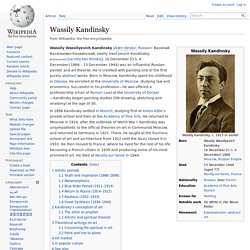
He is credited with painting one of the first purely abstract works. Organic architecture. Organic architecture is a philosophy of architecture which promotes harmony between human habitation and the natural world through design approaches so sympathetic and well integrated with its site, that buildings, furnishings, and surroundings become part of a unified, interrelated composition.
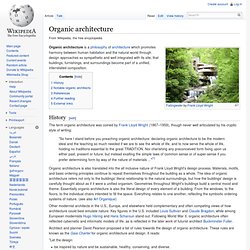
History[edit] The term organic architecture was coined by Frank Lloyd Wright (1867–1959), though never well articulated by his cryptic style of writing: "So here I stand before you preaching organic architecture: declaring organic architecture to be the modern ideal and the teaching so much needed if we are to see the whole of life, and to now serve the whole of life, holding no traditions essential to the great TRADITION. Nor cherishing any preconceived form fixing upon us either past, present or future, but instead exalting the simple laws of common sense or of super-sense if you prefer determining form by way of the nature of materials . Functionalism (architecture) Functionalism, in architecture, is the principle that architects should design a building based on the purpose of that building.
This statement is less self-evident than it first appears, and is a matter of confusion and controversy within the profession, particularly in regard to modern architecture. Functionalism had the strongest influence in Germany, Czechoslovakia, USSR and Netherlands. The place of functionalism in building can be traced back to the Vitruvian triad, where 'utilitas' (variously translated as 'commodity', 'convenience', or 'utility') stands alongside 'venustas' (beauty) and 'firmitas' (firmness) as one of three classic goals of architecture. Functionalist views were typical of some gothic revival architects, in particular Augustus Welby Pugin wrote that "there should be no features about a building which are not necessary for convenience, construction, or propriety" and "all ornament should consist of enrichment of the essential construction of the building".[1] Alvar Aalto.
Biography[edit] Life[edit] Alvar Aalto portrayed on a stamp published in 1976 The signature of Alvar Aalto on the wall of Jyväskylä's theatre building.

Henry van de Velde. Henry Clemens van de Velde (Dutch pronunciation: [ɑ̃ˈʁi vɑndəˈvɛldə]) (Antwerp, 3 April 1863 – Oberägeri, 15 October 1957[1]) was a Belgian painter, architect and interior designer.
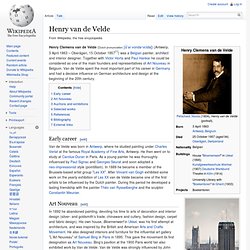
Together with Victor Horta and Paul Hankar he could be considered as one of the main founders and representatives of Art Nouveau in Belgium. Theodor Kittelsen. Theodor Kittelsen selfportrait Theodor Severin Kittelsen (27 April 1857 – 21 January 1914) was a Norwegian artist.
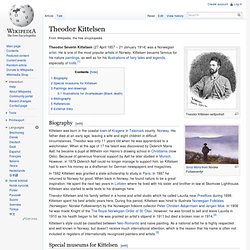
He is one of the most popular artists in Norway. Gustav Klimt (1862 - 1918) Charles Rennie Mackintosh. Charles Rennie Mackintosh Charles Rennie Mackintosh (7 June 1868 – 10 December 1928) was a Scottish architect, designer, water colourist and artist.
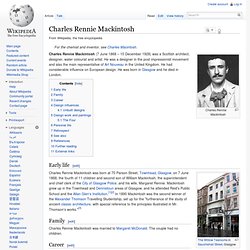
He was a designer in the post impressionist movement and also the main representative of Art Nouveau in the United Kingdom. He had considerable influence on European design. Art Deco. Historian Bevis Hillier defined Art Deco as "an assertively modern style [that] ran to symmetry rather than asymmetry, and to the rectilinear rather than the curvilinear; it responded to the demands of the machine and of new material [and] the requirements of mass production".[2] During its heyday, Art Deco represented luxury, glamour, exuberance and faith in social and technological progress. §Etymology[edit] The first use of the term Art Deco has been attributed to architect Le Corbusier, who penned a series of articles in his journal L'Esprit nouveau under the headline "1925 Expo: Arts Déco". He was referring to the 1925 Exposition Internationale des Arts Décoratifs et Industriels Modernes (International Exposition of Modern Decorative and Industrial Arts).[3] §Origins[edit]